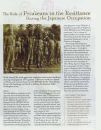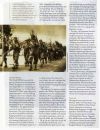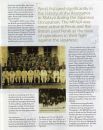We've tried to ensure the information displayed here is as accurate as possible. Should there be any inaccuracies, we would be grateful if you could let us know at info@ipohworld.org . All images and content are copyright.
(Please click on the thumbnail for a bigger image.)
An Article From Vicinity Perak - The Role Of Perakeans In The Resistance During The Japanese Occupation - Volume 2 Issue 12, September 2006






This article is about Perakeans who played important roles in the resistance during the Japanese occupation.
The only effective resistance to the Japanese forces during the occupation was by the Malayan People’s Anti Japanese Army (MPAJA) which was directed by the Communist Party of Malaya. CPM members, including those jailed by the British government, were released and trained as guerillas at the IOI Special Training School (IOI STS) in Singapore. The article also tells us how the young Chin Peng rose to the top of the CPM hierarchy assisted by Rashid Maidin and Abdullah CD.
There was another resistance movement by the name of Force 136 formed by British police officers and servicemen. On 1st January 1944, MPAJA agreed to co-operate with Force 136 in exchange for finance, arms, and training. The Force had three main branches namely the Kuomintang branch, the MPAJA branch, and the Malay Branch. The Malay branch was headed by Major Tengku Mahmood Nahyiddeen. Force 136 was later renamed Askar Melayu Setia. Many youngsters joined them and they became a force to be reckoned with. Majority of the patriots hailed from Perak and many of the government officials sent to spy on the Japanese were Perak born or affiliated to Perak in some way. Among the notables was YAM Raja Idris Shah who later became the 33rd Sultan of Perak.
The leader of the Chinese agents was Major Lim Bo Seng, a Malayan Kuomintang member. After their intelligence and spy network in Ipoh were blown, Lim Bo Seng was arrested by the Kempetai on the Gopeng – Kampar Road also known as Gui Meng Guan (Gates of Hell) because of the surprise checks carried out by the Kempetai. Lim Bo Seng later died in the Batu Gajah prison in June 1944 after being interrogated and tortured.
Sybil Kathigasu nee Sybil Dali and her husband Dr. A.C. Kathigasu were also mentioned for their selfless and patriotic acts. Sybil later died in Scotland after receiving the George Medal and her book, No Dram For Mercy was published posthumously in the year 1954.
The first picture on the left shows the Force 136 members and the following picture shows MPAJA guerillas coming out of the jungle prior to the establishment of the British Military Administration (BMA).
The third picture from left shows the Perak based Independent Regiment and at the bottom is the picture of Lahamat Mat Piah from Bersia village near Gerik who contributed much to Force 136.
The next picture from left (top) shows YM Leftenan Raja Lope and Lim Bo Seng meanwhile the picture at the bottom shows the remains of Lim Bo Seng exhumed after the Japanese Occupation and carried through the streets of Ipoh escorted by British troops, Chinese guerillas, and local citizens.
The picture on the fifth page, at the top, shows the portrait of Malaya’s war heroine Sybil Kathigasu. The picture on the extreme right page (centrepage) shows members of Force 136 entertained to a tea party by the Perak Chinese Kuomintang leaders after the Japanese surrender and the picture at the bottom shows Force 136 marching into Gerik town with the agreement of Colonel Fujiyama.
To read more about Sybil Kathigasu, click here.
To see more about Lim Bo Seng, click here.
To read more about the British Military Administration (BMA), click here.
To find out more about The Malayan People’s Anti-Japanese Army (MPAJA), click here.